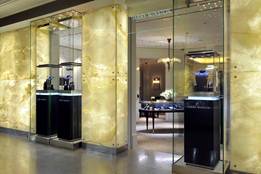The big news this week is the sale of famed jewellery and watch brand, Harry Winston, to the Swatch Group for $750 million plus their assumption of up to $250 million of pro forma net debt. Several analysts and industry observers see this as a risky bet for both parties.
Most believe that Swatch overpaid for Harry Winston but I tend to believe they know what they're doing. Swatch has been looking for a solid luxury jewellery investment for a long time. Harry Winston is one the best known luxury jewellery and watch brands in the world. It's not often that a brand like this becomes available. In addition, Swatch was reportedly was in the market for a diamond-heavy watch line, which Harry Winston is. There are approximately 27 Harry Winston retail locations throughout the world. This means there's plenty of room for growth, particularly in China where it has two locations. If there's any company capable of expanding the brand's presence, it's the Swatch Group.

The Harry Winston Salong in Harrods
Meanwhile, the debate swirling around the decision of Harry Winston Diamond Corp. (formerly Aber Diamond Corp.) to sell its retail business and go fully into the diamond mining business is a bit more complicated. The company holds a 40 percent stake in the Diavik diamonds mine in the Northwest Territories of Canada. The Rio Tinto Group owns the remaining 60 percent. The purchase of Harry Winston in 2006 was done so it could use the mine to supply its luxury retail division. The company also sells to the open diamond market through Antwerp.
This mine-to-market diamond philosophy was also controversial at the time and apparently became difficult to manage as the combined company reportedly incurred large debts. So the sale made sense in this regard. But the real reason they sold was to finance the $500 million purchase of the Ekati diamond mine, also in Canada's Northwest Territories, from BHP Billiton. There are reports that Harry Winston Diamond Corp., which will be called Domino Diamond Corp. after the sale is completed, also wants to buy the remaining stake in the Diavik mine.
The question is, why sell the luxury retail business to go into the full-scale diamond mining?
Luxury retail has been one of the consistent bright spots in world economy. Jewellery and watches (known as "hard luxuries") have been among the strongest performers in China, the world's fastest-growing luxury market.
Meanwhile, diamond prices have been in a state of flux for the past five years. During the past year, prices have dropped substantially. The two bright spots for the soon-to-be Domino Diamond Corp. are that Canadian diamonds are conflict-free, which may help increase their value, and it appears that Swatch will be a buyer of its product. The two companies said that they will explore the opportunities for a joint diamond polishing venture bringing together—so the mine-to-market model remains somewhat intact.




